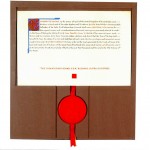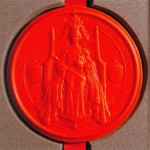Royal Warrant granted to the City of Stirling
In 2001, a competition was launched by The Lord Chancellors Department to create Scotland’s sixth city. The competition was part of a series of celebrations to mark the 50th anniversary of the Queen’s accession to the throne. There were four applicants for the competition: Stirling, Ayr, Paisley and Dumfries.
The result was announced in March 2002 in favour of Stirling, much to the delight of the inhabitants. After losing out to Inverness in 2000 as part of the Millennium celebrations, it was second time lucky for Stirling which had emerged victorious in the competition. Stirling’s Provost, Tommy Brookes, described the result as “a very special day for Stirling, which marks a watershed in the development of the whole area”.
The Queen came to visit on 24 May 2002. The occasion was to present the document that would symbolise and record the granting of city status to Stirling. A Royal Warrant was prepared to be signed by both the Queen and the Secretary of State for Scotland, Helen Liddle.
The Royal Warrant reads:
ELIZABETH THE SECOND by the grace of God of the United Kingdom of Great Britain and Northern Ireland and of our realms and territories, QUEEN, Head of the Commonwealth Defender of the Faith.
To all whom these Presents shall come Greeting. Whereas We for divers good causes and considerations Us thereunto moving are graciously pleased to confer on the Town of Stirling the status of a city. Now Therefore Know Ye that We of Our especial grace and favour and mere motion do by these Presents ordain declare and direct that the town of Stirling shall henceforth have the status of a City and shall have all such rank liberties privileges and immunities as are incident to a City. IN WITNESS WHEREOF We have ordered the seal appointed by Treaty of the Union to be kept and made use of in place of the Great Seal of Scotland to be appended hereto. GIVEN at Our Court at St. James’s the Twenty Second Day of April in the year Two Thousand and Two and in the Fifty First year of Our Reign.
PER SIGNATURAM MANU S.D.N. REGINAE SUPRA SCRIPTAM
Unfortunately, however, the signing of the Royal Warrant was not to be. Owing to an administrative mix up, there was no pen to hand and with no time in the Royal schedule to find one, the Queen continued on her itinerary leaving the document unsigned. This was the second time that there had been a problem with pens and royalty in Stirling. On a Scottish tour with the Duke of Edinburgh in 1961, the Queen was invited to sign the visitor’s book in the Stirling County Council offices at Viewforth. The pen, however, would not write. Anxious looking officials could only watch as an awkward silence held the room. The Scotsman reported that the Queen exclaimed “Oh Dear, I will have to use my own,” and took one out her handbag to sign the book!
There was some concern that the missing signature meant that the warrant was invalid but Council staff were assured by central government administrators that it was the issue of the latters patent that made the actual grant so the status of Stirling as a city is assured.
After the visit of the Queen to Stirling, the warrant was sent to the office of the Registers of Scotland where it was sealed with the Great Seal of Scotland. A special case was made to hold and preserve the warrant by conservation staff at the National Records of Scotland and it was presented to Stirling Council and then transferred to the Archives.
One of the most striking features of the Royal Warrant is the Great Seal. The seal was cast from organic Scottish beeswax and vermillion pigment. If you get close enough to smell the seal, you can still smell the heather that the bees fed on.

